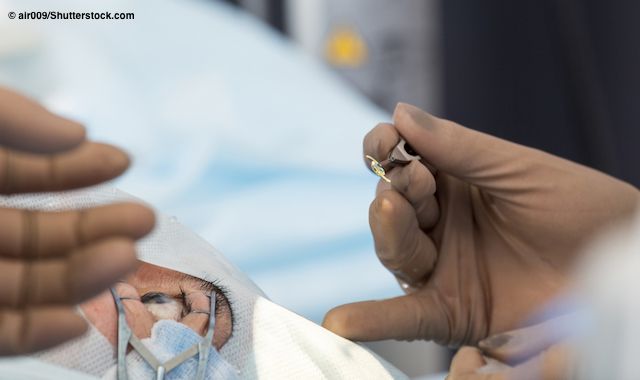Article
Study focusing on complete rotational stability of enhanced IOL platform
Author(s):
New technology offers surgeons the unfolding efficiency of an enhanced material along with the rotational stability that characterizes the current toric platform.

Surgeons who are using the current version of the aberration-neutral hydrophobic acrylic IOL (MX60E, Bausch+Lomb) appreciate that its enhanced material increased its unfolding speed compared with the original model (MX60, Bausch+Lomb).
Research presented by Anna M. Edmiston, MD, at the ASCRS-ASOA annual meeting, held May 3-7 at the Convention Center in San Diego, CA, suggests that as surgeons await the release of a toric version manufactured with the new technology, they can look forward to enjoying the unfolding efficiency of the enhanced material along with the excellent rotational stability that characterizes the current toric platform (MX60T, Bausch+Lomb).
“The enhanced MX60E, like its predecessor, features haptics with a broad surface of capsular contact, and therefore we expected it would have excellent in-the-bag stability,” said Dr. Edmiston, Cataract and Refractive Surgery Fellow, Jacksoneye, Lake Villa, IL. “However, we felt it was important to document the clinical performance of the new platform because rotational stability is a critical issue for successful outcomes with a toric IOL.”
Dr. Edmiston noted that the study is still underway and has a small sample size so far.
“The results are encouraging in showing that the redesigned platform for the aberration-neutral hydrophobic acrylic IOL is well-suited for toric technology,” she said.
Rotational stability
Together with her fellowship director, Mitchell A. Jackson, MD, founder/medical director, Jacksoneye, Dr. Edmiston undertook a study to investigate the rotational stability of the MX60E in patients undergoing femtosecond laser-assisted cataract surgery (FLACS) for visually significant cataracts.
The laser (LENSAR Laser, LENSAR) is being used to create anterior lens capsular marks on the steep corneal axis via ris registration from preoperative images acquired with a Scheimpflug imaging device (Pentacam, Oculus).
During surgery, fenestrations on the MX60E IOL are aligned with the capsular markings. The case is completed, and after the incisions are sealed, the position of the IOL relative to the capsular markings is documented through visual inspection. Changes in IOL position are evaluated at follow-up visits scheduled at 1 day, 1 week, and 1 month after surgery through examination of slit-lamp photographs taken through the dilated pupil.
“Visualization of the relationship between the fenestration holes in the monofocal IOL and the capsular markings at the slit-lamp can be challenging and requires a large pupil,” Dr. Edmiston said. “The toric IOL, however, features alignment marks on the optic that will make the assessment of its position relative to the capsular markings much easier.”
Patients enrolled in study
So far, nine patients have been enrolled in the study, and they represent a heterogeneous group with respect to range of axial length (22.11 to 26.13 mm), anterior chamber depth (2.27 to 3.89 mm), and IOL alignment axis (33° to 145°). Dr. Edmiston reported that six of the patients have completed the study.
“A review of their outcomes showed no cases of IOL rotation, and they achieved excellent refractive and functional outcomes,” she said.
Preoperatively the patients had a mean MRSE of -2.77 D, mean axial length of 24.67 mm, mean anterior chamber depth of 3.37 mm, mean white-to-white distance of 12.10 mm, mean Ks of 44.23/43.75 D, mean angle alpha of 0.35 mm, and mean angle kappa of 0.20 mm.
At one month, mean Ks were 44.57/44.17 D, mean MRSE was -0.04 D, and both mean BCDVA and mean UCDVA were 0.02 logMAR (Snellen 20/21)
Dr. Edmiston noted that the original monofocal MX60 IOL provided excellent quality of vision, and its constant power from center to edge and zero spherical aberration made it less sensitive to pupil size and mild decentration compared with aspheric IOLs that are designed with negative asphericity. The MX60 also provided high defocus tolerance, increased depth of field, and a material that is glistening-free and scratch-resistant.
“The MX60E retained all of the positive features of its predecessor with the advantage of a much shorter unfolding time.” said Dr. Edmiston.
The MX60T, which received FDA approval in 2018, provides all of the optical benefits of the monofocal platform and was proven in a prospective study to have excellent rotational stability.
FLACS assisted implantation
Dr. Edmiston also highlighted the benefit of the capsular marking feature that is available using the LENSAR femtosecond laser.
“The capsular markings are permanent, which makes them a reliable reference for both guiding toric IOL placement during surgery and evaluating alignment postoperatively. Compared with markings that are made within the cornea using other femtosecond lasers, the capsular marks reduce parallax error and therefore they may also allow for more accurate intraoperative positioning,” she noted.
Disclosures:
Dr. Edmiston has no relevant financial interests to disclose. Dr. Jackson is a consultant to Bausch+Lomb and LENSAR.
Newsletter
Don’t miss out—get Ophthalmology Times updates on the latest clinical advancements and expert interviews, straight to your inbox.





